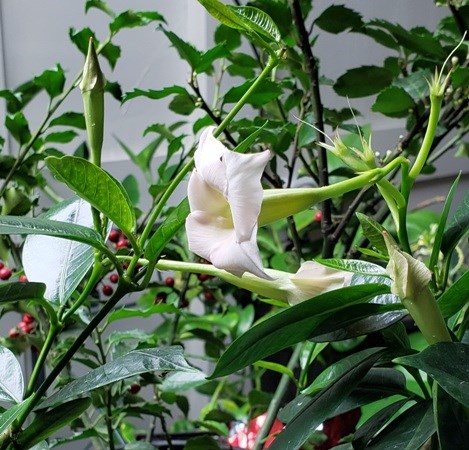Mandevillas are a genus (and the common name) of a vine that is tropical or subtropical in origin. It was first described as a genus in 1840 and is commonly called rocktrumpet. The genus was named after Henry Mandeville who was a British diplomat and gardener. They are native to the southwest United States, Mexico, South America, the West Indies and South America.
The flowers that make this spectacular vine so famous come in many colours including white, cream, purple red, pink and yellow. There have also been many new hybrids developed as both the flowers and the big shiny leaves are enjoyed by many. It is considered hardy to zone 9 and above, so if you live in a more severe climate, the mandevilla is an annual or will need to be brought inside. They will not tolerate temperatures below 10 C.
They are best grown in full sun when planted outside and if you wish to keep your mandevilla over the winter, it is best to have it in a container to allow for easy transition from outside to inside. Outside, it will grow rapidly so will need to be watered frequently so it will not dry out. During a short growing season, it will easily put on three to four metres of growth so ensure you have a plan for supporting the vine. Fertilize it regularly to ensure there is enough food for the plant to grow well. Some people prefer to use a dilute fertilizer solution each time they water, while others prefer to fertilize each week. When I plant anything in a container I always put some slow release fertilizer in the planting mix to take the pressure off of frequent fertilization chores.
If you plan on bringing your mandevilla inside, then gradually reduce the intensity of the sunlight a few weeks prior to moving it inside as even if you take it inside and place it directly under grow lights the light is much less inside. We have no chance of emulating the sun. It will likely also be necessary to cut back the plant to allow it to fit more easily inside. Place it in a large, sunny window or under a plant light. The more light you are able to provide, the better your mandevilla will do. Water a couple times a month as the growth will be limited, just ensure it does not dry out completely as that will result in leaf loss. It is not necessary to fertilize inside unless it is actively growing.
A word of caution. Anytime you bring plants in from outside at some point you will see a hatch of critters – they may be aphids, scale, mealybugs or even white flies. Do not panic. When I bring plants in I go through a bit of a routine. A few weeks prior to bringing them in I wash the whole plant off a few times just with water. I then do an insect treatment (with Neem or insecticidal soap) ensuring manufacturer guidelines are followed. I then rinse them again, let them dry and begin the moving of the plants themselves to their winter home.
Usually, about January or maybe February, I will see some evidence of new critters. It may be frass or the insects themselves, but it is key to ensuring you are observant prior to the world exploding. When that happens, there is not much choice in giving them the “F” treatment – freezing. They again become outdoor plants for a short period of time and insect infestation is history.
Spring is coming. Good luck in planning the upcoming year of growing outside!
Hanbidge is the Lead Horticulturist with Orchid Horticulture. Find us at www.orchidhort.com; by email at [email protected]; on facebook @orchidhort and on instagram at #orchidhort.




